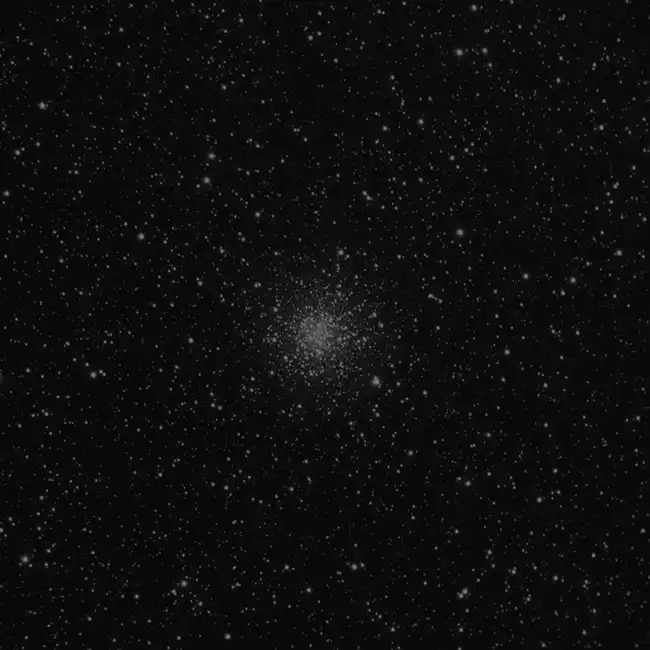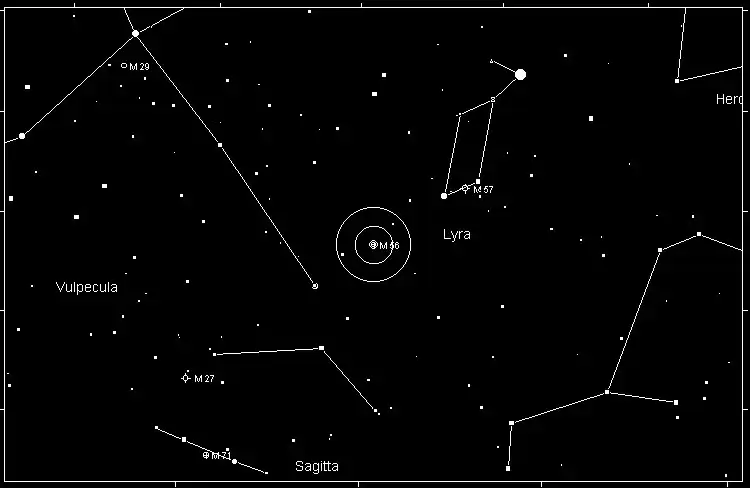Messier 56 (M56), also known as NGC 6779, is a globular cluster located in the constellation Lyra. This dense cluster of stars is situated around 32,900 light-years away from Earth and spans about 84 light-years across. Globular clusters like M56 are ancient, containing some of the oldest known stars in the universe, with ages estimated to be over 13 billion years. Unlike open clusters, which have a more irregular shape, globular clusters are densely packed and spherical in appearance. M56 is no exception, with hundreds of thousands of stars gravitationally bound into a tightly knit group.
The cluster has a somewhat loose structure compared to other globular clusters, making it less concentrated in its core. Its relative distance and faintness, combined with its loosely packed stars, make M56 a challenge to observe in smaller telescopes, but it’s a rewarding target for more advanced astronomers.
Magnitude
Messier 56 has an apparent magnitude of +8.3, which makes it too dim to be seen with the naked eye, but it can be observed with a decent pair of binoculars or a small telescope. Because it’s relatively faint, a dark sky free from light pollution is ideal for viewing this object. Under good conditions, it appears as a faint, fuzzy spot of light through a small telescope, while larger telescopes reveal individual stars within the cluster, especially near its outer edges.

Best Season to Observe
M56 is best observed during the summer months in the Northern Hemisphere. The ideal time to spot this globular cluster is from June to September, when the constellation Lyra is high in the sky during the evening hours. Observing in late summer will provide the best opportunity to view M56 when it is positioned well above the horizon.
Constellation and How to Find It
Messier 56 resides in the constellation Lyra, which is known for its brightest star, Vega, one of the three stars that form the well-known Summer Triangle asterism. Vega acts as a good starting point to locate M56. To find it, you can follow these steps:
- Locate the Summer Triangle: This asterism consists of the bright stars Vega (in Lyra), Deneb (in Cygnus), and Altair (in Aquila). Vega is the brightest of the three and is easy to spot high in the summer sky.
- Find the Constellation Lyra: Vega marks the top of the small parallelogram-shaped constellation Lyra.
- Locate M56: M56 lies roughly halfway between the stars Albireo in the constellation Cygnus (which marks the head of the swan) and Gamma Lyrae in Lyra. The distance between Albireo and Gamma Lyrae is about 7.5 degrees, and M56 is located about 4.5 degrees from Albireo.
Once you have located Albireo and Gamma Lyrae, slowly scan the area between these stars with your telescope. M56 will appear as a small, faint blob of light. A low-magnification eyepiece is recommended for the initial search, with higher magnification used once the cluster is located.

History
Messier 56 was discovered by the French astronomer Charles Messier on January 19, 1779, while he was searching for comets. Messier was known for cataloging objects that resembled comets but were actually stationary celestial objects like star clusters, nebulae, and galaxies. His catalog, which now bears his name, includes 110 of these objects, with M56 being one of the globular clusters included.
When Messier first observed M56, he described it as a "nebula without a star" and noted its round shape. It wasn’t until later that astronomers, using more powerful telescopes, resolved it into individual stars and recognized it as a globular cluster. The cluster was later added to the New General Catalogue (NGC) by John Louis Emil Dreyer and is still studied today as part of our understanding of globular clusters and the formation of the Milky Way.
In modern astronomy, M56 has been studied to better understand the dynamics of globular clusters, including stellar populations, motions, and the influence of the Milky Way's gravitational field on these ancient stellar systems. M56, like other globular clusters, provides insights into the early history of the galaxy and the evolution of stars.
Conclusion
Messier 56, while not one of the showiest globular clusters in the night sky, is a rewarding target for amateur astronomers equipped with a decent telescope. Its location in the constellation Lyra and its proximity to the Summer Triangle make it relatively easy to find once you know where to look. Whether you're observing with binoculars or a telescope, M56 offers a glimpse into the ancient past of the Milky Way and serves as a reminder of the vast, interconnected nature of our universe.
